ISSN ONLINE(2278-8875) PRINT (2320-3765)
ISSN ONLINE(2278-8875) PRINT (2320-3765)
| Rajesh Kr Ahuja, Lalit Aggarwal, Pankaj Kumar Department of Electrical Engineering, YMCA University of Science & Technology, Faridabad, Haryana,India |
| Related article at Pubmed, Scholar Google |
Visit for more related articles at International Journal of Advanced Research in Electrical, Electronics and Instrumentation Engineering
This paper presents the simulation of single phase three level, five level, seven level , nine level and eleven level inverters.. These different level inverters are realized by cascading one, two, three H- Bridges respectively in MATLAB. A multilevel inverter achieves high power ratings and improves the performance of the whole system in terms of harmonics. In this paper a simple control strategy is applied for switching the switches at appropriate conducting angles with suitable delays.. The Multilevel inverter is used to reduce the harmonics. The inverters with a large number of steps can generate high quality voltage waveforms. The simulation of single phase three level, five level, seven level, nine level and eleven level inverters is done in Matlab/Simulink. The FFT spectrums for the outputs are compared and presented to validate the proposed control strategy.
Keywords |
| Cascaded H-bridge inverter, multilevel inverter, MATLAB/SIMULINK, THD |
INTRODUCTION |
| The developments in power electronics and semiconductor technology have triggered the improvements in power electronic systems. So, different circuit configurations namely multilevel inverters have became popular and considerable interest by researcher are given on them. The output voltage waveforms in multilevel inverters can be generated at low switching frequencies with low distortion and high frequency. For a medium voltage grid, it is troublesome to connect only one power semiconductor switches directly [1], [2], [3]. As a result, a multilevel power converter structure has been introduced as an alternative in high power and medium voltage situations such as laminators, mills, conveyors, pumps, fans, blowers, compressors, and so on. The concept of multilevel inverters has been introduced since 1975. The cascaded multilevel inverter was first introduced in 1975. Separate DC-sourced fullbridge cells were placed in series to synthesize a staircase AC output voltage. The term multilevel began with the threelevel converter. Subsequently, several multilevel converter topologies have been developed. In 1981, diode-clamped multilevel inverter also called the Neutral-Point Clamped (NPC) inverter schemes were proposed [5]. In 1992, capacitor-clamped (or flying capacitor) multilevel inverters, and in 1996, cascaded multilevel inverters were proposed [1]. Although the cascade multilevel inverter was invented earlier, its application did not prevail until the mid 1990s.The advancements in the field of power electronics and microelectronics made it possible to reduce the magnitude of harmonics with multilevel inverters, in which the number of levels of the inverters are increased rather than increasing the size of the filters. The performance of multilevel inverters enhances as the number of levels of the inverter increases. In this paper the three level, five level, seven level, nine level and eleven level inverters are realized by cascading one, two, three, four and five H- Bridges respectively. The FFT spectrums for the outputs are presented to study the reduction in the harmonics. |
MULTILEVEL INVERTERS |
| The unique structure of voltage source inverters allows them to reach high voltages with low harmonics without the use of series-connected synchronized switching devices or transformers. The elementary concept of a multilevel converter to achieve higher power is to use a series of power semiconductor switches with several lower voltage dc sources to perform the power conversion by synthesizing a staircase voltage waveform. Capacitors, batteries, and renewable energy voltage sources can be used as the multiple dc voltage sources. The commutation of the power switches aggregate these multiple dc sources in order to achieve high voltage at the output; however, the rated voltage of the power semiconductor switches depends only upon the rating of the dc voltage sources to which they are connected. A multilevel converter can be implemented in many different ways. The simplest techniques involve the parallel or series connection of conventional converters to form the multilevel waveforms. More complex structures effectively insert converters within converters. The voltage or current rating of the multilevel converter becomes a multiple of the individual switches, and so the power rating of the converter can exceed the limit imposed by the individual switching devices. Several multilevel inverter topologies have been developed; i) diode clamped, ii) flying capacitors, and iii) cascaded or H-bridge. Referring to the literature reviews, the cascaded or H-bridge multilevel inverter with separated DC sources is clearly the most feasible topology for use as a power converter for medium & high power applications. |
CASCADED H-BRIDGE INVERTER |
| Cascaded H-Bridge configuration has recently become very popular in high-power AC supplies and adjustable-speed drive applications [4]. A cascade multilevel inverter consists of a series of H-bridge (single-phase full bridge) inverter units. Each H-bridge unit has its own dc source. Each SDC (separate D.C. source) is associated with a single-phase full-bridge inverter. The ac terminal voltages of different level inverters are connected in series. Fig. 1 shows a singlephase structure of a cascaded H-bridge inverter with separate D.C. sources. Through different combinations of the four switches, S1-S4, each converter level can generate three different voltage outputs, +Vdc, -Vdc and zero. To obtain +Vdc switches S1 and S4 are turned on. On turning on S2 and S3 together we get the output –Vdc. On turning the switches S1 and S2 together or S3 and S4 together or S1, S2, S3, S4 simultaneously we get the output 0. The AC outputs of different full-bridge converters are connected in series such that the synthesized voltage waveform is the sum of the individual converter outputs. In this topology, the number of output-phase voltage levels is defined by M= 2N+1, where ‘M’ is the no of levels and ‘N’ is the number of DC sources. So, for an example the output phase voltage of eleven level inverter is given by Van= Va1+Va2+Va3+Va4+Va5. |
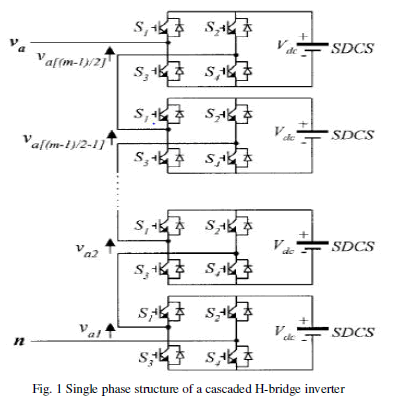 |
| From the single phase structure of a cascaded H-bridge inverter as shown in Fig. 1 above, we can make the three level, five level, seven level, nine level, and eleven level inverters without using any type of modulation technique, and by using the same mathematical relation M=2N+1 |
SIMULATION RESULTS |
| The MATLAB simulink is used to simulate 3, 5, 7, 9, and 11 level inverters with resistive load. Here the simulink model for only three level, five level and eleven level inverters have been shown, while the simulation and FFT results of all i.e. three, five, seven, nine and eleven inverters are shown . |
| The Matlab/Simulink model for three level inverter using only one H-bridge is shown below in Fig. 2: |
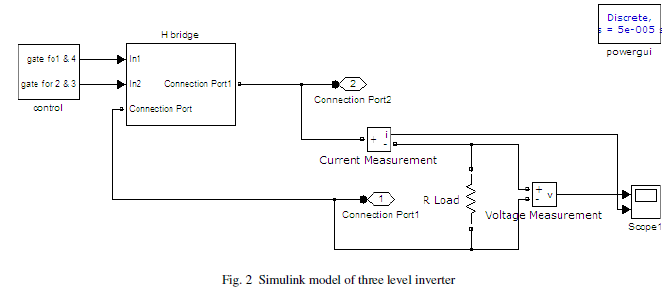 |
| The bridge circuit for the three level inverter is shown below in Fig. 3 below: |
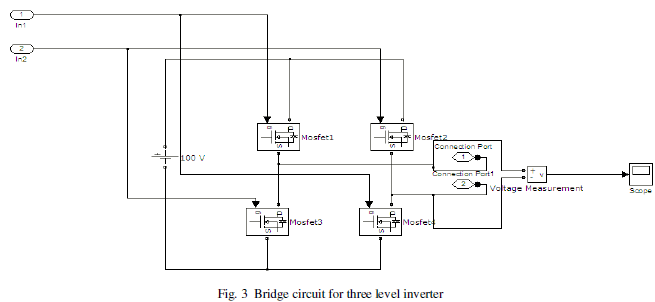 |
| The simulation result of three level inverter is shown below in Fig. 4 and the FFT analysis is done for voltage to study the reduction in harmonics and corresponding spectrum is shown in Fig. 5: |
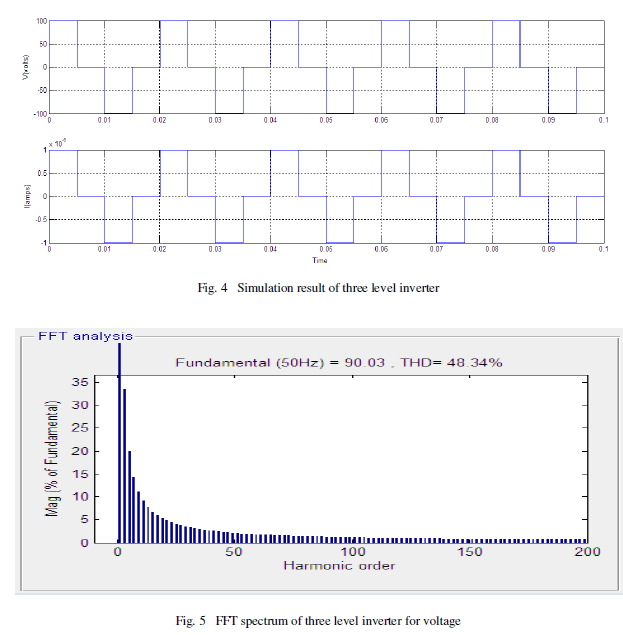 |
| The simulation result of five level inverter is shown below in Fig. 6 and the FFT analysis is done for voltage to study the reduction in harmonics and corresponding spectrum is shown in Fig. 7: |
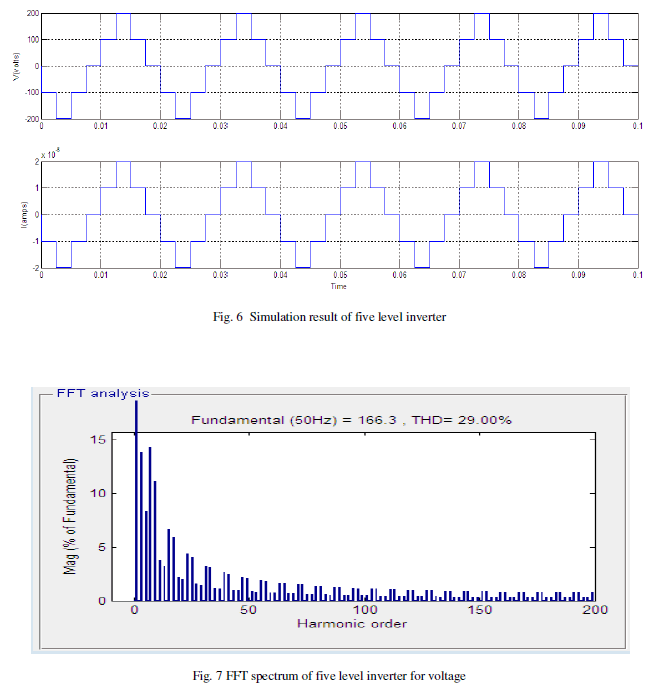 |
| The simulation result of seven level inverter is shown below in Fig. 8. |
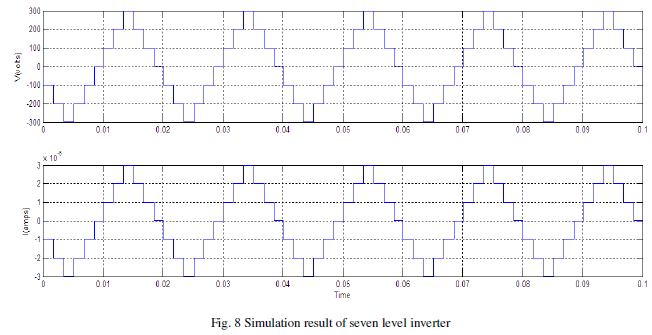 |
| The FFT analysis is done for voltage to study the reduction in harmonics and corresponding spectrum is shown below in Fig. 9: |
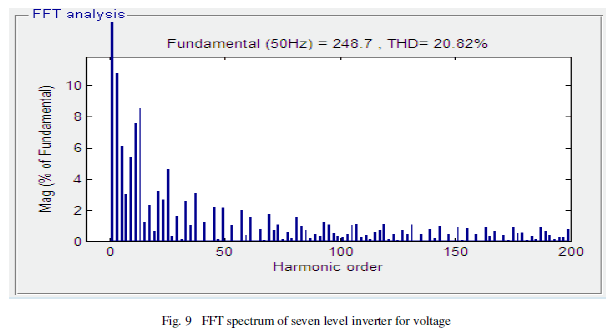 |
| The simulation result of nine level inverter is shown below in Fig. 10. |
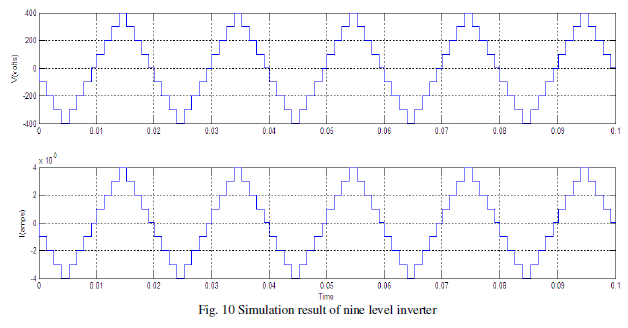 |
| The FFT analysis is done for voltage to study the reduction in harmonics and corresponding spectrum is shown below in Fig. 11: |
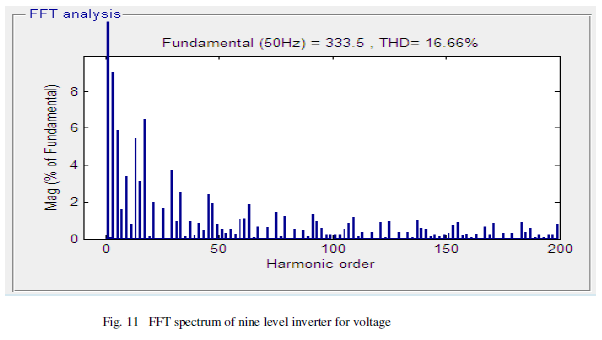 |
| The Matlab/Simulink model for eleven level inverter using five H-bridges is shown below in Fig. 12: |
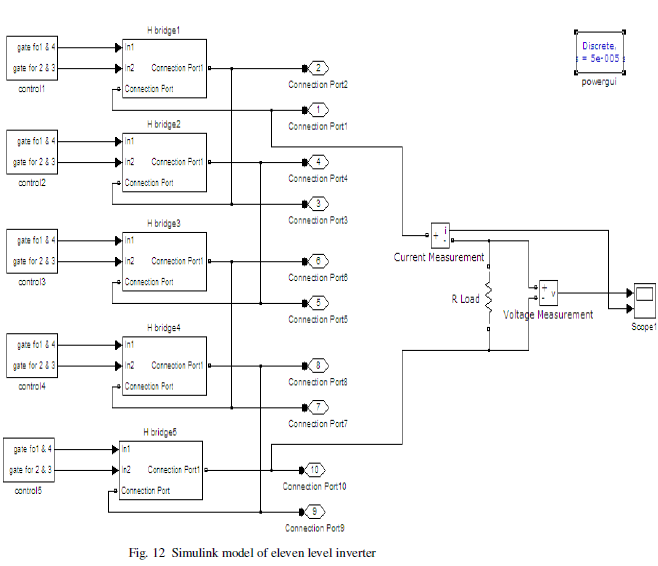 |
| The simulation result of eleven level inverter is shown below in Fig. 13: |
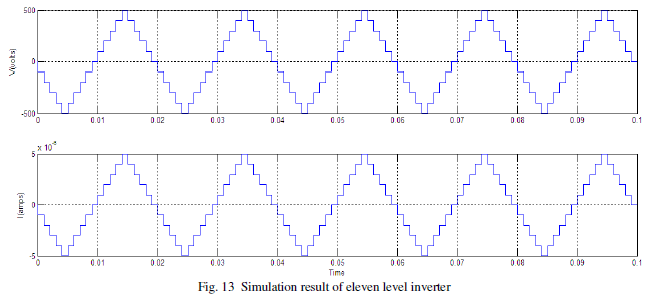 |
| The FFT analysis is done for voltage to study the reduction in harmonics and corresponding spectrum is shown below in Fig. 14: |
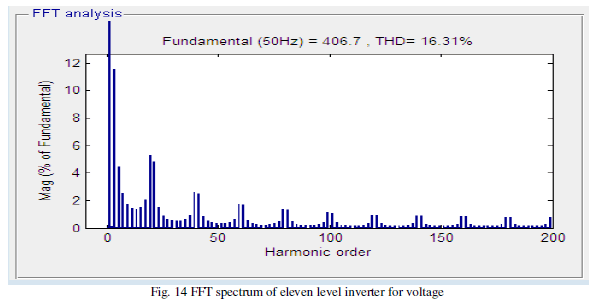 |
| The results are tabulated in Table 1 below: |
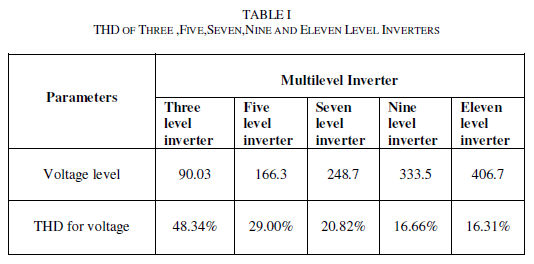 |
CONCLUSION |
| The simulation of three level, five level, seven level, nine level, and eleven level inverters are carried out in MATLAB/SIMILINK where a simple control strategy is applied for switching the switches at appropriate conducting angles with suitable delays. The total harmonic distortion for each level is calculated and compared for resistive load. From the different levels of simulation it is clear that THD can be decreased by increasing number of levels which validates the proposed control strategy. |
References |
|